|
A Hypothetical
History
Skyhawk
in Fleet Air Arm
Service Part One
by Jennings Heilig
|
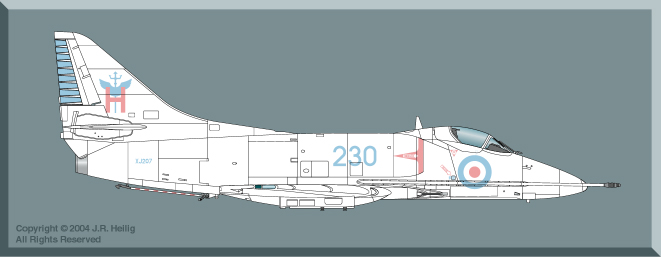 |
|
1. Skyhawk FG.1, XJ207, 801
Squadron, HMS Hermes, 1962
This aircraft represents the anti-flash white scheme
applied to most FG.1s at the factory. All colors were glossy,
and all markings (including the stripes on the arresting hook!)
were in the subdued colors. |

HyperScale is proudly supported by
Squadron.com
The ubiquitous Douglas A-4 Skyhawk was one of
those aircraft that was just “right” in all the right ways. It came
along at just the right time, and with all the attributes which
positioned it for a long and productive career with many of the
world’s air arms. Bolstered by early success with the U.S. Navy,
Douglas sales representatives scoured the world looking for
governments which might be interested in their bantam bomber.
Having designed the aircraft in as small a
package as possible, Ed Heineman’s little hot rod seemed a perfect
fit for the smaller sized fleet carriers of the Royal Navy.
Compared to their U.S. Navy brethren, the RN’s carriers were tiny.
Overhead spaces were lower, hangar decks were considerably smaller,
and the RN’s catapults were shorter and somewhat less powerful than
the American ones. This had less to do with British engineering
prowess than the RN’s lack of brutish, behemoth naval aircraft such
as the Douglas A3D Skywarrior, which required immensely strong
catapults and huge ships like the new Forrestal class to operate
from
The untimely death of Defense Minister Duncan
Sandys in an air-to-air missile accident in late 1957 meant that his
disastrous policy of putting all of the UK’s eggs into the missile
basket was reversed. Thus, it was at the Farnborough International
Airshow in 1958 that the RN announced that it had chosen the
littlest Douglas as its new light attack type. This announcement
was only possible because of a very sweet license production deal,
that deal only being politically acceptable because of the fact that
the A4D (as it was then known in USN parlance) was powered by a
U.S.-built version of the Armstrong Siddeley Sapphire engine. So
there would be a perception of turnabout being fair play by having
the Sapphire-powered Skyhawk built in the UK
A license to build the A4D-2 airframe was
awarded to Hawker Siddeley Aircraft, Ltd. Many items of British
equipment were substituted for American parts, including a
Martin-Baker ejection seat, a British-built Sapphire engine, and
many other items such as instrumentation, hydraulic components, etc
While Hawkers were gearing up for Skyhawk
production, Douglas shipped three aircraft in knocked-down kit form,
minus engines and other equipment. The initial version produced,
known as the Skyhawk FG.1, was equivalent to the USN’s A4D-2, later
known as the A-4C. The three Douglas-supplied aircraft (XJ201/203)
were used as patterns, allowing Hawker Siddeley to begin production
of the Skyhawk in record time. The first three aircraft spent their
entire lives as test articles, all three eventually (and very
tragically for history’s sake) being scrapped in the early 1970s
A
British Skyhawk for Britain
|
The first British-built Skyhawk FG.1 was
delivered to the Royal Navy in early 1959, going to the newly
established 800 Naval Air Squadron at Yeovilton. Over the next
forty-plus years, Yeovilton would become the RN’s Skyhawk haven,
with its familiar shape still visible over the Somerset countryside
even today.
Nuclear Skyhawk
One of the lesser-known, yet key aspects of the
decision to purchase the Skyhawk for the RN was its ability to
deliver tactical nuclear weapons. Since British and American
nuclear weapons shared much in common, it was a relatively easy
matter to adapt British nukes to the Skyhawk airframe. In keeping
with the fashion of the day, the first aircraft delivered were
finished in an overall glossy white color scheme, with pink and
light blue markings which were supposed to protect against thermal
damage to the aircraft’s skin when exposed to the blinding flash of
a nuclear detonation.
Being a small airframe with a British engine
and much other British equipment, the Skyhawk quickly found an
enthusiastic home in the Royal Navy. By 1960 several more squadrons
had equipped with FG.1s, and carrier operations were underway by the
end of that year.
With the introduction of the Polaris missile
into the Royal Navy’s submarine force in the mid-1960s, the Skyhawk
lost its nuclear tasking. As a result of this development, both its
operational role and its color scheme soon changed.
|
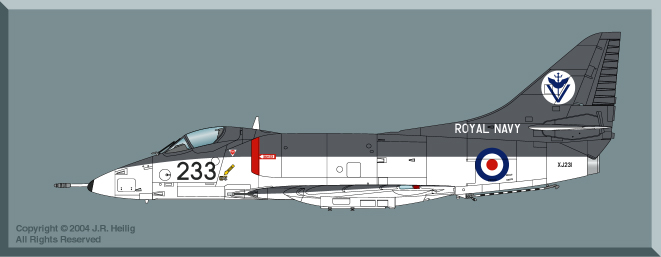 |
|
2. Skyhawk FG.1, XJ231, 801
Squadron, HMS Victorious,1965
After mission tasking was changed to conventional
attack, this color scheme was applied fleet-wide. The upper
surfaces were painted in glossy Extra Dark Sea Grey, with full
color markings. Unerwing serials were black. Note the
non-standard intake warning treatment onthis aircraft. |
Skyhawk pilots were back to training in
conventional tactics, and while ground attack and anti-shipping
operations were their major focus, air-to-air was also very much a
part of the game. The Skyhawk’s sprightly performance, excellent
maneuverability, and powerful 20mm cannons allowed its pilots to mix
it up with the best the RAF and NATO had to offer and come out, as
often as not, on top.
Skyhawk FG.2
After the production of 48 Skyhawk FG.1s, at
the end of 1964 production switched to the FG.2, equivalent to the
U.S. Navy’s A-4E. While the A-4E was up-engined with the Pratt &
Whitney J-52 turbojet, Hawker Siddeley wanted to keep things as
British as possible with its Skyhawks. Thus, the new Bristol
Siddeley Diamond turbofan was chosen to power the FG.2. This
powerful, lightweight engine actually provided more power for less
fuel consumption than the J-52, although initially its time between
overhauls was somewhat shorter. This problem was rectified in later
years, with the Diamond becoming one of the truly great British jet
engine designs. Being nearly identical to the J-52 in terms of size
and weight, fitting the Diamond into the Skyhawk airframe presented
few problems of note.
First deliveries of the FG.2 were made, once
again to Yeovilton, in June of 1965. Somewhat strangely, the
Skyhawk training organization was moved in 1966 to Lossiemouth,
Scotland. The typically grey, damp Scottish weather played havoc
with training schedules however, and soon the Skyhawk school was
back in the somewhat sunnier climes of Somerset.
|
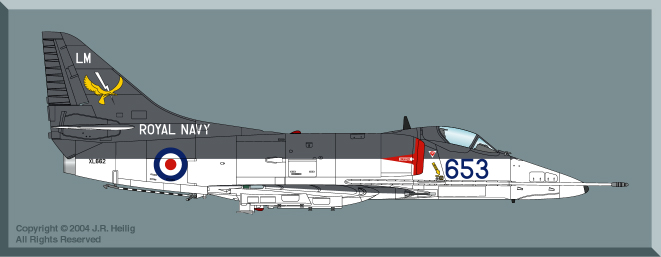 |
|
3. Skyhawk FG.2, XL662, Skyhawk
Training Flight, Lossiemouth, 1966
The Skyhawk school house at Lossiemouth applied side
numbers to its aircraft in Roundel Blue. Otherwise the scheme
is similar to the one above, with minor detail variations in the
demarcation line between upper and lower surface colors. Most
FG.2s left the factory in this color scheme. |
The FG.2 quickly supplanted the FG.1 in all of
the RN’s front line squadrons, with FG.1s either being scrapped or
moving into second line squadrons and the Royal Navy’s Air Reserve
Squadrons. The last FG.1 was struck off charge in 1980.
Fortunately, several examples were preserved in various museums
around Britain.
The first FG.2s wore the Extra Dark Sea Grey
over white colors of the later batches of FG.1s. By the late 1960s
however, this attractive scheme gave way to overall Extra Dark Sea
Grey, although colorful markings were still the norm for several
more years.
|
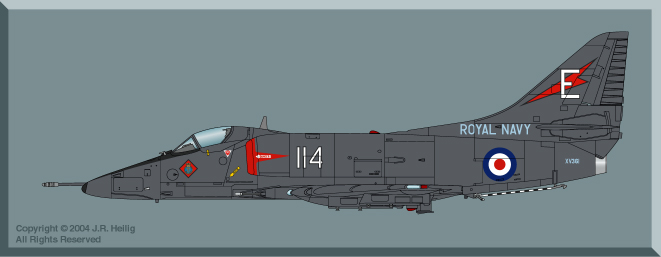 |
|
4. Skyhawk FG.2, XV361, 800
Squadron, HMS Eagle, 1971
By the late 1960s, the entire airframe was being painted
in glossy Extra Dark Sea Grey. Markings remained in full color.
This aircraft shows the Royal Navy titles and serials (both
fuselage and lower wing) in light blue. Some aircraft had these
items painted white. Note the matte black anti-glare panel. |
South Atlantic Skyhawks
By the late 1970s, tactical roundels without
the white center were used, although a reappearance of white
undersides and Type D roundels was seen briefly beginning in 1980.
War clouds were looming however, and in April of 1982 the Argentine
military junta invaded and occupied the Falkland Islands. Believing
the UK did not have the political will to try to retake them, the
Argentine generals gravely miscalculated the resolve of the “Iron
Lady”, Prime Minister Margaret Thatcher, and war was unavoidable.
The RN Skyhawk squadrons were notified that
they would be going to war during April of 1982, and preparations
were soon underway. During the 1970s, defense cuts meant that many
of the proposed upgrades to the Skyhawk fleet were not undertaken.
Such items as a modern HUD, internal ECM and RHAW gear, and other up
to date electronics and weapons were never purchased. While still a
very capable type, the Skyhawk first went to war with the Royal Navy
in very much the same form in which it had been built many years
before, and still very much a 1950s vintage fighter.
One very noticeable item that changed quickly
on the trip to the South Atlantic was the smart color scheme worn by
the Skyhawks. White undersides and all squadron markings were
overpainted (often with a 4-inch brush or a roller!) in Extra Dark
Sea Grey. Serials and side numbers were repainted in black, with
the first digit of the side number being deleted by some squadrons.
Roundels were hastily changed from the three-color Type D to a sort
of oddball variation of the tactical roundel, with the much smaller
red center spot of the Type D being retained, and the white ring
simply overpainted with Roundel Blue.
|
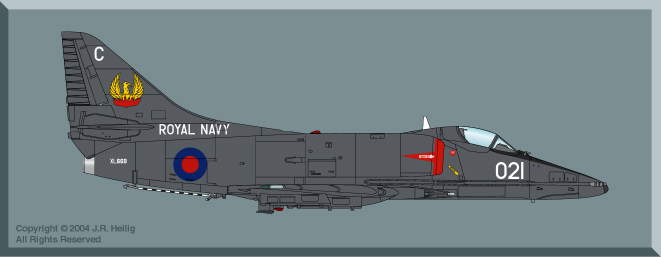 |
|
5. Skyhawk FG.2, XL669, 809
Squadron, HMS Courageous, 1978
Having previously been strictly an ASW carrier, HMS
Courageous only operated Skyhawks on one cruise before being
decommissioned in 1979 (when her replacement, the nuclear
powered HMS Triumphant was commissioned). This aircraft
displays the bent refuelling probe retrofitted fleet-wide
(except for T.4s) in the mid-1970s. It also displays the
tactical style roundels, and the EDSG overall is now
semi-matte. Underwing serials remain in white. |
During the transit southward, Skyhawk pilots
practiced both air-to-ground and air-to-air tactics. The French Air
Force kindly provided realistic training against the Mirage III, as
this was one of the primary Argentine Air Force types being deployed
against the Falklands.
Skyhawk vs. Skyhawk
Of course, the Argentines also had Skyhawks,
and this would be the first (and only) time that Skyhawk vs. Skyhawk
combat would occur. Royal Navy pilots mixed it up with each other,
and U.S. Navy and Marine Corps A-4 adversary squadron pilots, plus
several from the Royal New Zealand Air Force were ‘loaned’ to the RN
for a couple of weeks in order to provide as much dissimilar
training as was possible. The Americans and Kiwis posed as
Argentines, putting their Skyhawks through their paces, and helping
their British cousins gain valuable experience in air-to-air tactics
against their own aircraft type.
|
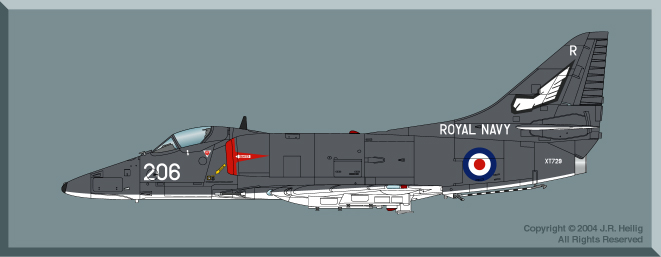 |
|
6. Skyhawk FG.2, XT729, 899
Squadron, HMS Ark Royal, early 1982
In 1980 many FG.2s started appearing from rework with glossy
camouflage and full color markings. The white lower surfaces
(with black serials) reappeared, and the black anti-glare panel
disappeared. XT729 is shown just prior to hostilities in the
Falklands. |
The Royal Navy had successfully integrated the
magnificent American AIM-9L Sidewinder missile into the Skyhawk
FG.2’s suite of weapons in the late 1970s, and it would be this, as
much as anything, that tipped the balance in favor of the RN Skyhawk
squadrons in the Falklands.
The Argentines fought incredibly bravely, but
lacked a modern AAM for their Skyhawks. In the one instance during
the conflict where two RN Skyhawks, having expended their AIM-9Ls,
ended up in an old fashioned dogfight with two FAA Skyhawks using
only cannons, the contest ended in a one-all tie.
|
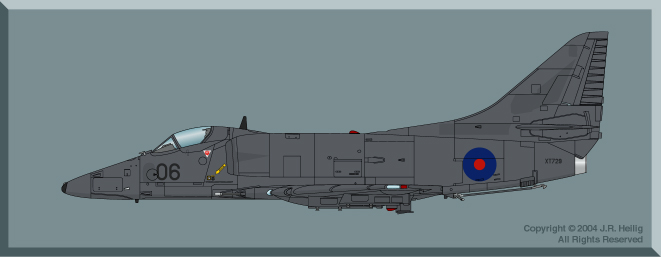 |
|
7. Skyhawk FG.2, XT729, 899
Squadron, HMS Ark Royal, Falkland Islands, June 1982
What a difference a month makes! Here we see XT729 as repainted
while on the transit southward to the Falklands. All lower
surfaces and most markings (including lower wing roundels &
serials) have been overpainted in EDSG. Roundels have had their
center white ring overpainted with Roundel Blue, and the
fuselage serial and truncated side number have been reapplied in
black. Although XT729 did not score any victories during the
conflict, many Skyhawks did, and most had small silhouettes of
the aircraft type destroyed applied in black below the
windscreen on the left side. |
Another quickly applied ‘fix’ for combat in the
South Atlantic was a chaff/flare launcher. These had been tested on
RN Skyhawks, but not adopted for cost reasons. Fortunately many
appropriate units were available from redundant American A-4s in
storage in Arizona, so a deal was quickly struck and a C-5 Galaxy
load of launchers was delivered in time to be fitted to those
aircraft destined for combat in the Falklands. These proved their
worth several times by successfully defeating both the early model
AIM-9 Sidewinders used by the Argentine Air Force, and the Roland
missiles fired from ground positions around Stanley and Goose Green.
Click here to go to Part Two
Text and Images Copyright © 2004 by
Jennings Heilig
Page Created
17 June, 2004
Last updated
12 August, 2004
Back to HyperScale Main
Page
Back to Reviews
Page
|
Home |
What's New |
Features |
Gallery |
Reviews |
Reference |
Forum |
Search